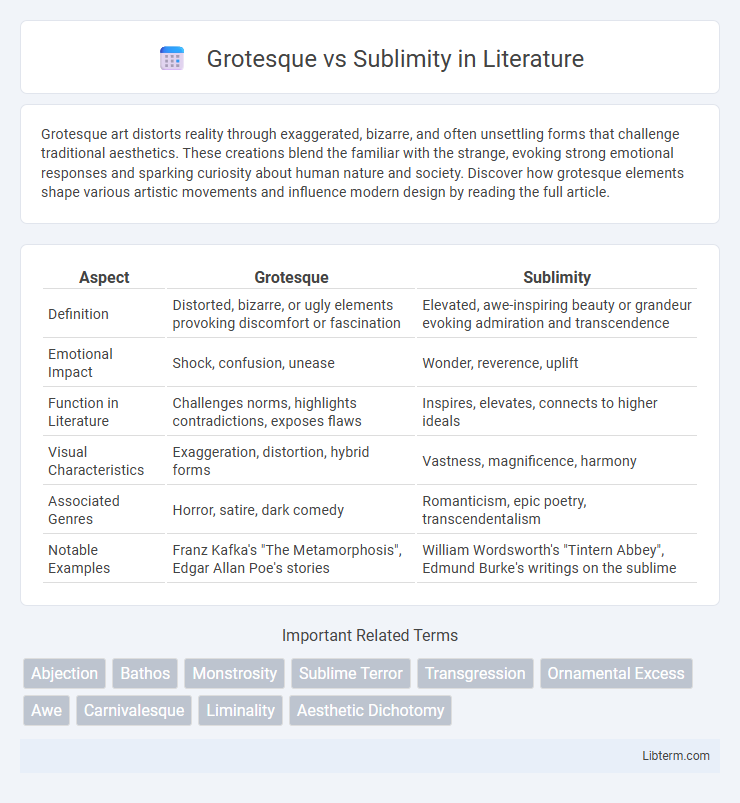Grotesque art distorts reality through exaggerated, bizarre, and often unsettling forms that challenge traditional aesthetics. These creations blend the familiar with the strange, evoking strong emotional responses and sparking curiosity about human nature and society. Discover how grotesque elements shape various artistic movements and influence modern design by reading the full article.
Table of Comparison
| Aspect | Grotesque | Sublimity |
|---|---|---|
| Definition | Distorted, bizarre, or ugly elements provoking discomfort or fascination | Elevated, awe-inspiring beauty or grandeur evoking admiration and transcendence |
| Emotional Impact | Shock, confusion, unease | Wonder, reverence, uplift |
| Function in Literature | Challenges norms, highlights contradictions, exposes flaws | Inspires, elevates, connects to higher ideals |
| Visual Characteristics | Exaggeration, distortion, hybrid forms | Vastness, magnificence, harmony |
| Associated Genres | Horror, satire, dark comedy | Romanticism, epic poetry, transcendentalism |
| Notable Examples | Franz Kafka's "The Metamorphosis", Edgar Allan Poe's stories | William Wordsworth's "Tintern Abbey", Edmund Burke's writings on the sublime |
Defining Grotesque: Origins and Meaning
The grotesque originates from ancient Roman frescoes discovered in the 15th century, characterized by bizarre, distorted figures combining human and animal features. It embodies a fusion of horror and humor, evoking unease through exaggerated, unnatural forms that challenge conventional aesthetics. This art style contrasts with sublimity, which evokes awe and beauty, by emphasizing the strange and unsettling aspects of imagery.
Understanding Sublimity: Historical Perspectives
Historical perspectives on sublimity reveal its evolution from classical philosophy to Romanticism, where thinkers like Longinus emphasized emotional grandeur and transcendence. The sublime captivates through overwhelming beauty or terror, evoking a complex psychological response that exceeds ordinary experience. Unlike the grotesque, which distorts reality to provoke discomfort, sublimity elevates perception toward awe and spiritual elevation.
Key Differences Between Grotesque and Sublime
Grotesque art emphasizes the bizarre, distorted, and unsettling aspects of form, often combining human and animal features to evoke discomfort or humor. In contrast, the sublime highlights vastness, beauty, and transcendence, inspiring awe and profound emotional impact through grandeur and magnificence. While grotesque challenges conventional aesthetics with absurdity and deformity, the sublime uplifts by evoking intense feelings of wonder and spirituality.
The Emotional Impact of Grotesque Art
Grotesque art evokes a strong emotional response by blending horror and fascination through distorted, exaggerated forms that challenge viewers' perceptions of beauty and normalcy. The unsettling imagery often provokes feelings of discomfort, curiosity, and awe, reflecting deep psychological tensions between fear and attraction. This intense emotional impact contrasts with sublimity, which inspires awe through beauty and grandeur, highlighting grotesque art's unique power to engage complex and contradictory human emotions.
Sublimity in Literature and Visual Arts
Sublimity in literature and visual arts evokes profound awe by transcending ordinary experience through vastness, grandeur, or intense emotion, often invoking feelings of both beauty and terror. This aesthetic concept emphasizes the infinite, the overwhelming, and the mysterious, as seen in Romantic poetry by authors like Wordsworth and visual masterpieces such as Caspar David Friedrich's landscapes. Sublimity invites viewers and readers to confront the limits of human perception, stirring a heightened sense of spiritual or existential reflection beyond the grotesque's distortion and exaggeration.
Intersections: When Grotesque Meets Sublime
The intersections between grotesque and sublimity reveal complex emotional responses that challenge traditional aesthetic boundaries by merging horror with awe. This fusion manifests in art and literature through distorted forms that evoke both repulsion and admiration, highlighting the uncanny and transcendent qualities simultaneously. Exploring these intersections deepens understanding of how human perception negotiates tension between the abject and the exalted, enriching interpretations of sublime experiences intertwined with grotesque imagery.
Cultural Significance of Grotesque Imagery
Grotesque imagery holds deep cultural significance by challenging social norms and provoking emotional responses through exaggerated, distorted forms that blur boundaries between human and monstrous. It serves as a powerful tool in art and literature to expose societal anxieties, question beauty standards, and reflect collective fears or taboos. The grotesque contrasts with sublimity by emphasizing discomfort and the uncanny, thus fostering critical engagement with cultural identity and moral ambiguity.
Sublimity in Nature: Awe and Fear
Sublimity in nature evokes a powerful blend of awe and fear, highlighting the vastness and mystery of natural landscapes such as towering mountains and stormy seas. This emotional response transcends mere beauty, engaging the human psyche with feelings of insignificance and reverence. Unlike the grotesque, which often distorts and shocks, sublimity in nature elevates perception through overwhelming grandeur and primal force.
Grotesque and Sublimity in Modern Media
Grotesque imagery in modern media often evokes a visceral reaction by distorting reality through exaggerated, unsettling, or monstrous features, creating a sense of discomfort or fascination. Sublimity contrasts this by inspiring awe and transcendence, often through vast, powerful, or sublime landscapes and moments that elevate the viewer beyond ordinary experience. The interplay between grotesque and sublimity in film, video games, and digital art highlights the tension between horror and beauty, chaos and order, pushing the boundaries of emotional and aesthetic engagement.
The Enduring Appeal of the Grotesque and Sublime
The enduring appeal of the grotesque lies in its ability to evoke both fascination and repulsion by distorting reality and challenging conventional aesthetics. Sublimity captivates audiences through awe-inspiring grandeur and profound emotional experiences that transcend ordinary perception. Together, the grotesque and sublime persist in art and literature by engaging the complex human psyche through contrasting yet complementary extremes of beauty and horror.
Grotesque Infographic

 libterm.com
libterm.com